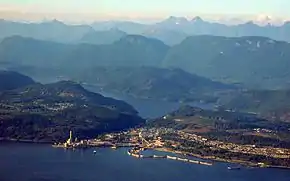The Hulks
The Hulks or The Giant Hulks, more formally known as the Powell River Floating Breakwater, is a floating breakwater off the Sunshine Coast of British Columbia, a Pacific coast province of Canada. The breakwater is a prominent landmark of the city of Powell River and may be the largest floating breakwater in the world.

The breakwater consists of floating concrete ships from the World War II era and one, the SS Peralta, from World War I era. Steel was in short supply during wartime leading to ship-makers to resort to alternatives such a concrete. These heavy, awkwardly maneuverable ships were called "hulks".

It was originally constructed by the Powell River Company, a pulp and paper mill, and the ships help form their log pond.
The ships
The Powell River Company originally purchased 19 ships for their fleet.
- YOGN 82
- SS Peralta, last WWI era concrete ship still floating
- USS Quartz
- Emile N. Vidal
- M. H. Le Chatelier
- P. M. Anderson
- John Smeaton
- Thaddeus Merriman
- L. J. Vicat
- Armand Considere
- M. H. Le Chatelier
Configuration
As seen from left to right from the coast, the configuration of the ships is given roughly below.
?–2002
- YOGN 82
- M. H. Le Chatelier
- USS Quartz
- P. M. Anderson
- SS Peralta
- Emile N. Vidal
- John Smeaton
- Thaddeus Merriman
- L. J. Vicat
- Armand Considere
2002–2018
The ship's were re-arranged in 2002.[1]
- YOGN 82
- SS Peralta
- USS Quartz
- Emile N. Vidal
- M. H. Le Chatelier
- P. M. Anderson
- John Smeaton
- Thaddeus Merriman
- L. J. Vicat
- Armand Considere
2018–?
In 2018, YOGN-82 was towed away and sunk to form an artificial reef. The first of four designated for that purpose.
References
Further reading
- Campbell, John A. (2003). Hulks: The Breakwater Ships of Powell River. Works Publishing. ISBN 9780968735183.